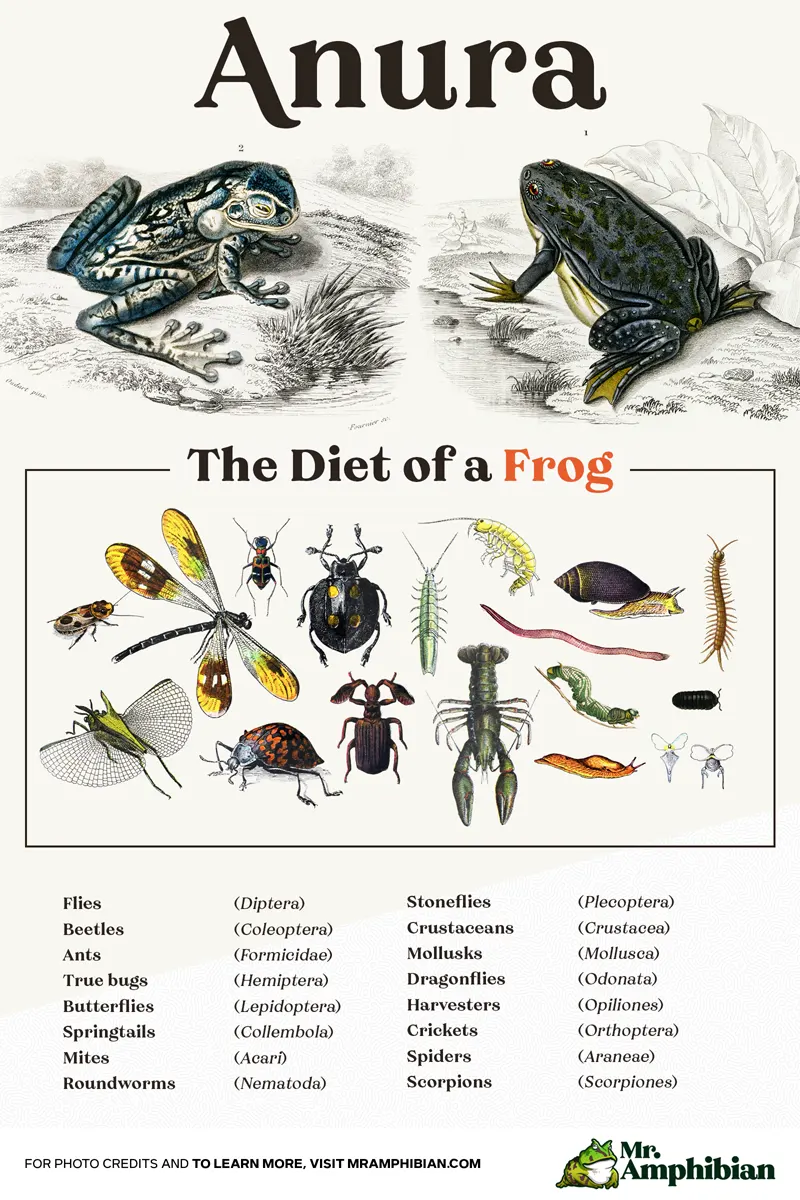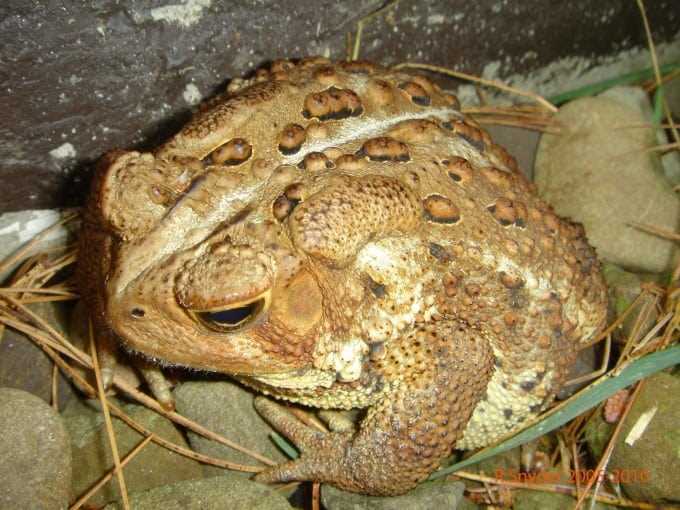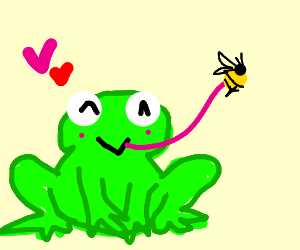
Frogs are fascinating creatures that inhabit various ecosystems around the world. These amphibians have evolved to thrive in a wide range of habitats, from lush rainforests to dry deserts. While many people may associate frogs with eating insects, such as flies or mosquitoes, the question remains: can frogs eat bees?
The answer to this question is not as straightforward as one might think. While frogs do consume a variety of insects as part of their diet, bees are not typically a common prey item for them. Frogs are opportunistic predators, meaning they will eat whatever food source is available to them. However, bees, with their stingers and quick flight, are not the easiest meal for a frog.
The Diet of Frogs: What Do They Eat?
Frogs are fascinating creatures that have adapted to a wide range of habitats around the world. One of the most intriguing aspects of their biology is their diet. What do frogs eat? This is a question that has puzzled scientists and nature enthusiasts for centuries.
Frogs are primarily carnivorous and have a diverse diet that includes insects, spiders, worms, snails, and even small vertebrates like mice or other frogs. They are opportunistic eaters, meaning that they will eat whatever is available and fits into their mouth. This adaptability is one of the reasons why frogs have been able to survive and thrive in so many different environments.
So, do frogs eat bees? While many species of frogs consume insects as part of their diet, bees are not typically a common food item for them. Frogs tend to prey on insects that are easier to catch and swallow, such as flies, mosquitoes, or grasshoppers. Bees, with their stingers and fast flying capabilities, are not an easy target for frogs.
However, it is worth noting that some species of frogs have been observed consuming bees, especially when other food sources are scarce. This behavior is more commonly seen in certain tree frog species that inhabit tropical rainforests, where bees may be more accessible due to the abundance of flowering plants.
Are Bees Part of a Frog’s Natural Diet?
Types of Bees
Frog Diets
The diet of a frog largely depends on its species and habitat. While some frogs primarily consume insects, others may have a more varied diet that includes small vertebrates. However, most frogs are carnivorous and rely on consuming prey to fulfill their nutritional needs.
Possible Predators
Although frogs are capable of eating bees, it is not a common part of their natural diet. Some species of frogs may consume bees if they encounter them, especially if they are opportunistic feeders. However, the majority of frogs do not actively seek out bees as a source of food.
Potential Consequences

Additionally, bees play a crucial role in pollination, which is essential for the reproduction of many plants. By consuming bees, frogs may inadvertently contribute to the disruption of ecosystems and the decline of bee populations.
Conclusion
The Anatomy of a Frog: Adaptations for Eating
Frogs have a unique feeding mechanism that sets them apart from other animals. Their mouth is wide and can open to a significant extent, allowing them to swallow prey whole. Their jaws are highly flexible and can protrude outward to accommodate large prey items.
Another crucial adaptation for eating is the presence of a long, sticky tongue. This tongue is attached at the front of the frog’s mouth and can extend quickly to catch prey. Once the prey is caught, the frog retracts its tongue back into its mouth, bringing the meal with it.
In addition to their unique mouth and tongue adaptations, frogs also have a specialized digestive system. Once the prey is swallowed, it passes through the esophagus and into the stomach. Frogs have powerful stomach muscles that contract and grind the food, aiding in digestion.
After digestion in the stomach, the food moves into the small intestine, where nutrients are absorbed into the frog’s bloodstream. The remaining waste material then travels through the large intestine and is eventually eliminated from the body through the cloaca.
Overall, the anatomy of frogs is specifically adapted for consuming a wide range of prey, including bees. Their wide mouths, flexible jaws, sticky tongues, and specialized digestive system all work together to facilitate the ingestion and digestion of various foods.
Can Frogs Physically Consume Bees?
Do frogs eat bees?
Frogs have been observed consuming various types of insects, including flies, beetles, ants, and grasshoppers. Their diets primarily consist of small organisms that are easily caught with their long, sticky tongues. However, the consumption of bees by frogs is not typically common.
The Adaptations of Frogs for Eating
To understand if frogs can physically consume bees, it is crucial to explore their anatomical adaptations. Frogs have specialized mouths and tongues that enable them to capture prey quickly. Their tongues are attached to the front of the mouth and can extend rapidly, allowing them to catch insects in an instant.
Frogs also have an adaptation called a maxillary arcade, which helps them hold onto their prey while it is being swallowed. This structure ensures that the food stays in place and does not escape during the feeding process.
The Possibility of Frogs Consuming Bees
While bees are not a typical dietary item for most frogs, there have been some observations of frog species consuming bees. These instances, however, are relatively rare, as bees are generally not a significant part of a frog’s natural diet.
Types of Frogs That May Eat Bees
Although it is not common, some frog species have been observed consuming bees more frequently than others. For example, certain tree frog species in tropical regions have been known to feed on bees as part of their diet.
These specific frog species are likely adapted to their environment and have developed specialized strategies for capturing and consuming bees. However, it is crucial to note that this behavior is not representative of all frog species.
Bee Toxicity and Frog Survival
Another factor to consider when discussing frogs consuming bees is the potential toxicity of bees. Bees can be equipped with venomous stingers, which can cause harm to predators. For some frog species, consuming bees may lead to negative effects on their health or survival.
The Potential Consequences of Eating Bees
While some frog species may include bees in their diet, consuming bees can still have some potential consequences. Depending on the species and individual frog, the consumption of bees can lead to allergic reactions or digestive issues.
The Evolutionary Role of Bees in Frog Diets
Although bees are not a significant part of a frog’s diet, their presence in certain frog species’ diets showcases the diverse nature of frog feeding habits. It also highlights the adaptability of frogs to different environments and food sources.
Frog Predators: Do They Consume Bees?
While frogs are not typically known to specifically target bees as a primary food source, there have been instances where certain species of frogs have been observed consuming bees. These instances are usually limited to frogs inhabiting areas where bees are abundantly available.
Frog Species That May Eat Bees
One species of frog that has been known to eat bees is the Green Tree Frog (Hyla cinerea). These frogs are commonly found in the southeastern United States, where bees are plentiful. They have been observed catching and consuming bees during their feeding activities.
Another species is the African Bullfrog (Pyxicephalus adspersus), which is native to sub-Saharan Africa. These frogs have a highly diverse diet and have been known to consume bees along with other insects, small mammals, and even other frogs.
Bee Toxicity and Frog Survival
In most cases, frogs are relatively immune to the effects of bee stings due to their unique physiology. Their skin is thick and moist, which prevents venom from easily penetrating their bodies. Additionally, certain species of frogs have developed a tolerance to bee venom. However, this immunity may not be present in all frog species.
The Potential Consequences of Eating Bees
While the consumption of bees by frogs may not commonly result in negative consequences for the frogs, there are potential risks involved. The venom from bee stings can still cause discomfort and irritation to the frog’s digestive system. In some cases, the venom may cause inflammation or damage to the frog’s internal organs.
Furthermore, bees are important pollinators in ecosystems, playing a crucial role in the reproduction of plants. If frogs were to consume large quantities of bees, it could potentially disrupt this pollination process and have ecological implications on the local plant life.
The Evolutionary Role of Bees in Frog Diets
Overall, while bees may not be a staple in a frog’s diet, their consumption by certain species of frogs suggests that there may be an evolutionary relationship between bees and frogs. It is possible that frogs have adapted to include bees in their diet to take advantage of the available food source.
Further research is needed to fully understand the intricacies of this relationship and to determine the long-term effects of bee consumption on frog populations and their ecosystems. The study of frog diets and their interactions with other organisms continues to provide valuable insights into the fascinating world of amphibians.
Types of Frogs That May Eat Bees
It is worth mentioning that while frogs may eat bees, this does not necessarily mean that bees are their preferred or main source of prey. Bees may only make up a small portion of their diet, especially if other food sources are readily available.
Bee Toxicity and Frog Survival
Bees play a crucial role in pollination and maintaining the balance of ecosystems. However, their stings can be harmful and even fatal to many animals, including frogs.
Toxicity of Bee Stings
Anaphylaxis is an extreme allergic response that can cause severe swelling, difficulty breathing, and even death. While it is uncommon for frogs to be allergic to bee venom, the risk is still present.
Frog Adaptations
Frogs have evolved various adaptations to survive in their environments, including protection against potential threats. Some frog species have developed specialized skin secretions that can neutralize or minimize the effects of toxins, including bee venom. These secretions act as a natural defense mechanism, allowing frogs to deter or even survive bee stings.
Additionally, frogs have a unique digestive system that enables them to metabolize a wide range of food items, including insects. This adaptation allows frogs to digest and process bee venom, reducing its potential harmful effects.
Impact on Frog Survival

Despite the potential dangers of bee stings, frogs have been observed consuming bees in their natural habitats. This suggests that some frog species have developed a tolerance or resistance to bee venom, allowing them to incorporate bees into their diets.
However, the consumption of bees may still have negative effects on frog survival. The venomous nature of bees makes them a risky prey item, and consuming bees regularly could increase the chances of a severe allergic reaction or other adverse effects.
Additionally, the availability of bees as a food source may vary depending on the region and the abundance of bees. Changes in bee populations due to habitat loss, pesticide use, or climate change could impact the diet and survival of frog populations.
Conclusion

Frogs have the ability to eat bees, but the potential risks associated with bee venom should not be overlooked. While some frog species have developed adaptations to minimize the toxic effects of bee stings, it is essential to consider the potential consequences on frog survival and the overall ecological balance.
Further research is needed to understand the full extent of bee toxicity on frogs and the long-term implications for their populations. Protecting and preserving bee populations and their habitats is not only vital for pollination but also for the survival of frogs and other wildlife that may interact with bees in their natural diets.
The Potential Consequences of Eating Bees
Frogs are well-known for their ability to consume a wide variety of insects and other small prey. However, not all insects are suitable or safe for frogs to eat. Bees, in particular, can pose potential risks and consequences when consumed by frogs.
If a frog manages to catch a bee, the bee will likely sting the frog’s internal organs as it is being swallowed. The venom from the bee’s sting can lead to inflammation, pain, and even death for the frog. The toxins present in the bee’s venom can have fatal effects on the frog’s respiratory and nervous systems.
Additionally, the physical structure of bees can also pose challenges for frogs. Bees have a hard exoskeleton, making them difficult to digest. The chitinous exoskeleton of bees can cause blockages in a frog’s digestive system, leading to complications and potential harm to their health.
Furthermore, the potential consequences of eating bees go beyond the immediate risks to the frog’s well-being. Bees play a vital role in pollination, which is crucial for the reproduction of many plant species. By consuming bees, frogs may inadvertently contribute to the disruption of ecosystems by decreasing the population of important pollinators.
Conclusion
The Evolutionary Role of Bees in Frog Diets
Bees are not typically considered a primary food source for frogs. Frogs generally feed on insects, small invertebrates, and sometimes even small vertebrates like fish or mice. However, certain types of frogs may opportunistically consume bees if they are readily available and easy to catch.
The consumption of bees by frogs is influenced by various factors, including the frog’s habitat and available food sources. While bees may not be a regular part of a frog’s natural diet, they can be an occasional supplement to their regular food sources.
Frogs have evolved to have specific adaptations that make it possible for them to consume a wide range of prey, and this includes bees. Their tongue is specialized in catching fast-moving insects and has adhesive properties that help secure the prey. Additionally, their teeth are designed to hold onto and crush small prey items like bees.
| Frogs | Bees |
|---|---|
| Frogs generally feed on insects, small invertebrates, and sometimes even small vertebrates | Bees are not typically considered a primary food source for frogs |
| Some frogs may opportunistically consume bees if they are readily available and easy to catch | Bees may not be a regular part of a frog’s natural diet, but they can be an occasional supplement |
| Smaller species may have difficulty catching and swallowing bees due to their size | Larger frogs with a wider mouth and more robust anatomy are better equipped to consume bees |
| Bees’ venom can cause inflammation, pain, and allergic reactions in frogs | The toxins present in bees are not always easily metabolized by frogs |
| The evolutionary role of bees in frog diets may involve trade-offs between benefits and risks |

I’m Lena Adams—a product of an unconventional upbringing in the African wilderness. My father, a daring explorer of African wildlife, sparked my fascination with reptiles, a passion that intertwined with the tragic loss of my mother during an expedition, leaving an indelible mark on my life. Driven to understand the creatures that captivated my parents, I embarked on my journey, sharing insights about reptiles, frogs, and lizards on my website. Through my explorations and conservation efforts, I honour my family’s legacy while seeking connections—to the creatures, nature, and the mother whose presence I yearn to understand.
